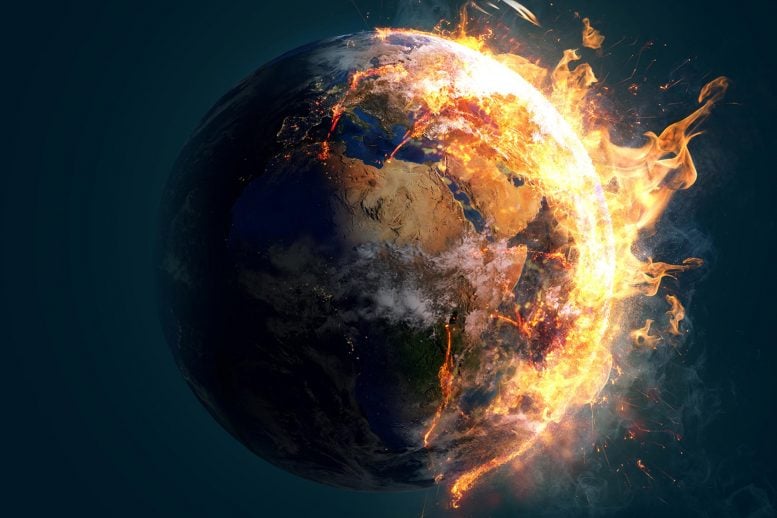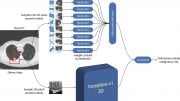
A collaborative study has revealed a correlation between climate change and the occurrence of pandemics in the Roman Empire, suggesting that climate-induced stress may have played a role in triggering these outbreaks. This research underscores the importance of examining the links between climate change, health, and societal resilience to better prepare for future challenges.
Specimens obtained from the seabed offer the inaugural detailed local climatic history and establish a connection to widespread disease outbreaks.
Is there a link between climate change and pandemics? A groundbreaking study conducted by researchers from MARUM – Center for Marine Environmental Sciences and the Department of Geosciences at the University of Bremen, alongside the University of Oklahoma in the USA, establishes a connection between variations in temperature and precipitation and the occurrence of pandemics. They have constructed the first high-resolution climate archive of the Gulf of Taranto (Italy) by analyzing sediments from the seabed, which they then correlated with pandemic events during the Roman Empire.
For their study in Science Advances, the researchers reconstructed temperatures and precipitation for the period from 200 BC to 600 AD, with a resolution of three years. This means that two data points cover a period of three years – an extremely high resolution for paleoclimate researchers. The period extends from the so-called Roman Climatic Optimum to the Late Antique Little Ice Age. This period also includes three major pandemics known from historians’ records: the Antonine Plague (around 165 to 180 AD), the Cyprian Plague (around 251 to 266) and the Justinian Plague (from around 540).
Each of these pandemics followed a change in climate: the Antonine Plague occurred during a cold spell that followed several decades of cooling and drought. The Cyprian plague coincided with a second phase of severe cooling. Finally, the Justinian Plague followed an extreme cooling in the 6th century. “There was always a parallel,” explains first author Prof. Karin Zonneveld from MARUM and the Department of Geosciences at the University of Bremen. “A phase of climate change was followed by a pandemic outbreak.”
Methodology and Findings
Zonneveld and her colleagues used so-called dinoflagellates to reconstruct past temperature and precipitation patterns. These unicellular organisms live in the sunlit upper part of the ocean and form cysts that are deposited as fossils on the ocean floor. Dinoflagellates have different preferences for their environment, with some living only in colder waters and others only in warmer waters.
Some prefer waters with lots of nutrients, while others can only live in very clean, nutrient-poor waters, explains Zonneveld. “If the conditions in the upper waters change, the composition of the cyst species that accumulate on the seabed also changes.” This creates a very high-resolution archive that goes back further than, for example, tree rings in this region can.
Karin Zonneveld and her colleagues took the samples from a core originating from the Gulf of Taranto. Volcanoes regularly erupt in southern Italy – the most prominent example is the eruption of Mount Vesuvius in 79 AD, which destroyed Pompeii. The ash emitted rises into the atmosphere, trickles down onto the water, and then sinks to the seabed. There it forms a thin layer of ash, known as a cryptotephra.
“Volcanic ash contains many small glass particles that can easily be seen with a polarizing microscope,” explains Karin Zonneveld. “The elemental composition of the glass particles in the ash of each volcano is unique and can even be different for individual eruptions of the same volcano. With the help of tiny needles, we were able to pick out individual pieces of glass and analyze their elemental composition in collaboration with the Bremen volcanologist Andreas Klügel.” In this way, the deposits could be precisely linked to volcanic eruptions of the Vesuvius and volcanoes on the island of Lipari of which the times of the eruptions was known. This allowed an exact dating of the core sediments.
Collaborative Insights and Conclusions
For the missing piece of the puzzle, a coincidence brought Zonneveld together with her co-author, historian Prof. Kyle Harper from the University of Oklahoma (USA). He, too, had long suspected a causal link between climate and pandemics. Together, they were able to precisely date and compare the climate data as well as glass particle analyses with historical events.
The researchers conclude that climate-related stress could trigger a pandemic outbreak or intensify disease outbreaks – for example, because food is scarce and people become more susceptible for diseases.
Harper and Zonneveld agree that this could hold important information for the future: “It’s true that we have a completely different society at the moment than in ancient times, mainly because of modern science and everything that goes with it – germ theory, antibiotics, vaccines, clean water. But there are also parallels. Much like in Roman times, climate is still an important factor affecting fundamental aspects that influence our well-being. These include agriculture, access to clean water, biodiversity, geographical distribution, and migration of organisms. Studying the resilience of ancient societies to climate change and exploring how climate change and the incidence of infectious diseases are linked could give us a better insight into the climate change-related challenges we face today.”
Reference: “Climate change, society, and pandemic disease in Roman Italy between 200 BCE and 600 CE” by Karin A. F. Zonneveld, Kyle Harper, Andreas Klügel, Liang Chen, Gert De Lange and Gerard J. M. Versteegh, 26 January 2024, Science Advances.
DOI: 10.1126/sciadv.adk1033









When big pharma funds medical research it is not real research.
Follow the money also applies to climate research.
Bingo.
Hard to take articles like this seriously when the site puts up dumb images like earth on fire.
LMAO propaganda machine has to keep moving
Funding: We acknowledge financial support by the Geoscience Department at the University of Bremen (K.A.F.Z. and A.K.); Department of Classics and Letters, University of Oklahoma (K.H.); German Research Foundation, grant ZO114/15-1 (dating); German Science Foundation, grant DFG Cluster of Excellence (EXC): “The Ocean Floor – Earths Uncharted Interface” 2019–2025, RECEIVER Unit 3 (G.J.M.V.); German Science Foundation Heisenberg, grant VE86/2, 3, 4 (G.J.M.V.); and ESF, EUROMARC grants ZO114/2-1 and VE486/1 (G.J.M.V. and L.C.).
It is worth studying. Changes in climate have ended empires. If the seasonal rains fail for a few years, the harvests fail, and the empire falls.
Ocean floor cysts probably aren’t significantly linked to any historical or possible pandemic. This criticism actually aligns with the bias of the article, as the obvious solution to the problems the article raises is hyper-industrialization. If climate is changing, as it did for the Roman Empire, then we need “antibiotics, vaccines, clean water”, and the mass-infrastructure to provide that to all people. If “food is scarce and people become more susceptible for diseases”, then we need a healthcare industry revolution worldwide, and desalinization and agriculture irrigation and building greenhouses on a geoengineering scale. The link given between pandemics and climate change is insignificant, to the benefit of anyone concerned about either problem.
An alternative working hypothesis is that they have come up with evidence for a spurious correlation. That is, what is going on is that cold weather reduced harvests, leading to a shortage of food, which weakened the population, and caused them to be more susceptible to disease. Three instances is hardly enough evidence to reach a robust conclusion, particularly if they haven’t looked for evidence of increased price of food or obvious shortages indicated by a change in eating habits. This is one of the risks of deciding that anything undesirable happening to a society is ‘obviously’ caused by temperature changes, before the research even begins.
I think the first comment here well says what I was going to mention. Changes in temperature change food production, weakening human populations and introducing new paths for pathogens.
And note, this is true of any local climate change as well.
The global economy has been vulnerable for years, so Im not sure this will be a surprise. Maybe more research into say, the American Chestnut plague or the infections spreading through other species might be interesting from a pure science viewpoint.